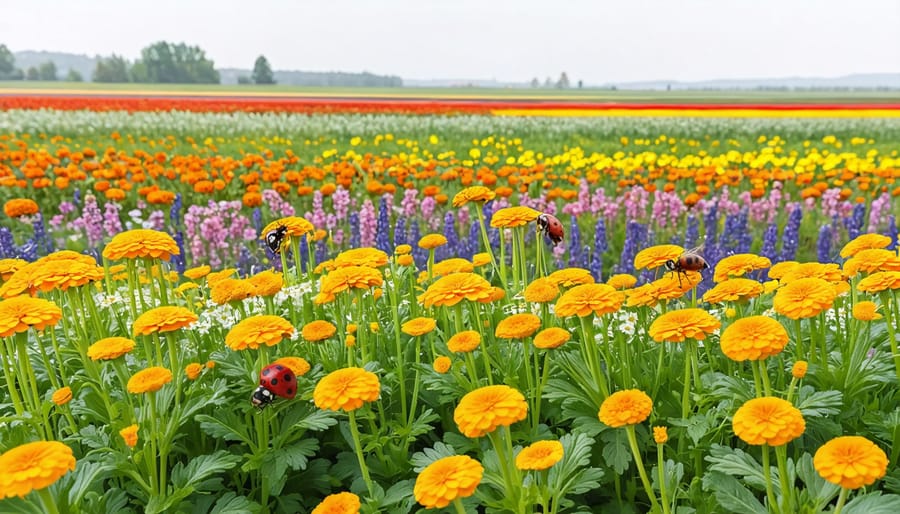Building effective community pest control starts with coordinated action across neighborhoods and farms. When Alberta communities unite against common agricultural pests, from grasshoppers to Richardson’s ground squirrels, success rates increase dramatically while costs decrease for everyone involved.
Successful community-wide pest management requires three core elements: early detection networks, shared resources, and synchronized treatment schedules. By establishing monitoring stations every 2-3 kilometers and using a centralized reporting system, communities can track pest movements and predict outbreaks before they become severe. This proactive approach has helped regions like Lethbridge County reduce pest-related crop losses by 40% over the past five years.
The most effective programs leverage both traditional knowledge and modern integrated pest management (IPM) strategies. Local agricultural societies across Alberta have demonstrated that when farmers coordinate their pest control timing and methods – from cultural controls to careful pesticide applications – they create zones of protection that benefit entire regions. Recent community initiatives in Central Alberta have shown that collaborative approaches reduce individual farm pest control costs by up to 30% while improving overall effectiveness.
Through shared equipment programs, bulk purchasing agreements, and coordinated implementation schedules, communities transform isolated efforts into powerful collective action against agricultural pests.
Building Your Local Pest Management Network
Identifying Key Stakeholders
Successful community pest control starts with bringing together the right people at the right time. In Alberta’s agricultural communities, this typically begins with identifying three core stakeholder groups: local farmers, agricultural experts, and municipal authorities.
Start by connecting with neighbouring farms within a 5-10 kilometre radius, as pests don’t recognize property boundaries. Create a contact list of local producers and organize an initial meeting, perhaps at your local community centre or agricultural society building. Consider reaching out through existing farming networks or your local Agricultural Service Board.
Agricultural experts play a crucial role in providing scientific guidance and monitoring. Connect with provincial extension specialists, crop consultants, and researchers from institutions like Olds College or the University of Alberta. These professionals can offer evidence-based strategies and help track pest populations throughout the season.
Municipal authorities and agricultural fieldmen are essential partners, as they can coordinate resources and ensure compliance with local regulations. They often have access to mapping tools, historical pest data, and can help secure funding for community-wide initiatives.
Remember to include representatives from Indigenous communities, organic farmers, and conservation groups in your stakeholder network. Their traditional knowledge and alternative pest management approaches can provide valuable perspectives for developing comprehensive control strategies.
To maintain engagement, establish regular communication channels through quarterly meetings, WhatsApp groups, or email newsletters. This keeps everyone informed and allows for quick responses when pest issues arise.
Creating Communication Channels
Establishing robust monitoring and reporting systems is crucial for successful community pest control efforts. Start by creating a centralized communication hub that all community members can easily access. This could be a dedicated WhatsApp group, a local web portal, or a combination of digital and traditional communication methods to ensure inclusivity.
Set up a clear reporting structure where farmers can quickly share pest sightings, outbreaks, or emerging threats. Many Alberta communities have found success using mobile apps that allow members to upload photos and GPS coordinates of pest activity. These real-time updates help neighbouring farms prepare and respond proactively.
Consider implementing a tiered alert system: green for routine monitoring, yellow for potential threats, and red for active infestations requiring immediate community response. Designate community coordinators for different areas who can verify reports and coordinate response efforts.
Regular check-ins through monthly meetings or virtual gatherings help maintain engagement and provide opportunities for knowledge sharing. Create a standardized reporting template that includes essential information like pest type, location, severity, and control measures attempted. This systematic approach ensures that valuable data is collected consistently and can be used to track patterns and improve future responses.
Remember to maintain open lines of communication with local agricultural extension offices and pest management experts who can provide additional guidance and support when needed.

Sustainable Pest Control Strategies That Work
Natural Predator Conservation
Supporting beneficial insects and wildlife is a cost-effective and environmentally sustainable approach to pest control that many Alberta farmers have successfully implemented. By creating habitats that attract natural predators, communities can establish long-term pest management solutions without relying heavily on chemical interventions.
Key strategies include maintaining hedgerows and windbreaks with native plants, which provide shelter for birds, bats, and predatory insects. Installing barn owl boxes and hawk perches has proven particularly effective in rodent control, with several Peace River region farmers reporting significant reductions in vole populations.
Creating insectary strips with flowering plants like yarrow, dill, and goldenrod attracts beneficial predatory insects such as ladybugs, parasitic wasps, and lacewings. These insects naturally control aphids, caterpillars, and other crop-damaging pests. Some communities have established shared pollinator gardens that serve both as habitat corridors and educational spaces.
Water features, such as small ponds or wetland areas, can attract amphibians like toads and frogs that feed on various agricultural pests. Maintaining these features requires community coordination, but the benefits extend beyond pest control to include improved biodiversity and natural ecosystem resilience.
Remember to avoid disturbing these natural predator habitats during critical seasons and consider implementing reduced tillage practices where possible to protect ground-dwelling beneficial species.

Crop Rotation Planning
Coordinating crop rotation plans with neighboring farms is one of the most effective community-based approaches to pest management in Alberta. When adjacent farms synchronize their rotation schedules, they create natural barriers that disrupt pest life cycles across the entire area.
In the Red Deer County region, farmers have successfully implemented a collaborative rotation system where they divide crops into four main groups: cereals, pulses, oilseeds, and cover crops. By rotating these groups systematically and in coordination with neighbors, they’ve reported up to 40% reduction in pest-related crop damage.
To start a community rotation plan, begin by mapping out your area’s current crop distribution. Meet with neighboring farmers during the winter planning season to discuss upcoming rotations. Consider establishing a shared calendar or using agricultural planning apps that allow for easy visualization of rotation patterns across multiple properties.
Key factors to consider when coordinating rotations include:
– Similar crop families should be planted at least 2 kilometres apart
– Synchronize fallow periods to break pest cycles
– Plan trap crops strategically around community boundaries
– Account for prevailing wind patterns when placing susceptible crops
The Lacombe Agricultural Research Station has documented that farms participating in coordinated rotation programs experience significantly fewer pest outbreaks compared to those operating in isolation. This community approach not only reduces pest pressure but also promotes soil health and biodiversity across the entire farming region.
Biological Control Methods
Implementing organic pest control solutions at a community level has shown remarkable success across Alberta’s farming communities. These methods leverage natural predator-prey relationships and beneficial organisms to manage pest populations effectively.
Local farmers have reported significant success with the introduction of parasitic wasps to control cabbage moths and ladybugs for aphid management. In the Lethbridge region, community-wide deployment of bird houses has attracted insect-eating birds, creating a natural defense against crop-damaging pests.
Beneficial nematodes have proven particularly effective in controlling soil-based pests, with several communities coordinating their application timing to maximize impact. Many farmers are also incorporating companion planting strategies, using aromatic herbs like dill and cilantro to attract beneficial insects across property boundaries.
The Medicine Hat Agricultural Cooperative has successfully implemented a rotating schedule for releasing predatory mites, which has reduced spider mite populations by 75% across participating farms. This coordinated approach ensures that biological control agents maintain their presence throughout the growing season.
Conservation strips and beetle banks, established through community collaboration, provide year-round habitat for beneficial insects. These structures, when implemented across multiple properties, create corridors that enhance the movement and sustainability of natural pest predators.
Success Stories from Alberta’s Fields

The Red Deer Valley Initiative
In 2019, farmers in Alberta’s Red Deer Valley faced one of the worst grasshopper infestations in recent memory. Rather than tackle the problem individually, local agricultural producers formed the Red Deer Valley Initiative (RDVI), demonstrating the power of collaborative pest management.
The initiative began when Sarah Thompson, a third-generation farmer, noticed that individual control efforts weren’t yielding results. “Grasshoppers don’t respect property lines,” Thompson explains. “We needed everyone on board to make a real difference.”
Working with local agricultural extension officers, the RDVI developed a coordinated approach that involved 47 farms covering approximately 28,000 hectares. Farmers synchronized their monitoring schedules and treatment applications, creating an effective barrier against grasshopper migration.
The group implemented a rotating schedule for pest surveys, sharing equipment and expertise. They established a mobile messaging system to alert neighbours about grasshopper movements and coordinated spraying activities to maximize effectiveness while reducing overall pesticide use by 30%.
The initiative’s success went beyond pest control. Participants reported significant cost savings through shared resources and bulk purchasing of control products. More importantly, the community built lasting relationships that continue to benefit other agricultural activities.
By the end of the 2020 growing season, participating farms reported an average 65% reduction in crop damage compared to non-participating neighbours. The RDVI model has since been adopted by other farming communities across Alberta, showcasing how local collaboration can effectively address pest challenges while strengthening community bonds.
Lethbridge County’s Integrated Approach
Lethbridge County’s success in developing a community-wide pest management strategy has become a benchmark for agricultural regions across Canada. Their integrated approach combines traditional farming knowledge with innovative monitoring systems and collaborative decision-making processes, demonstrating how communities can work together in winning the pest battle without chemicals.
The program’s cornerstone is its comprehensive monitoring network, where local farmers contribute real-time data about pest populations and crop health through a user-friendly mobile app. This information feeds into a central database, allowing agricultural specialists to identify emerging threats and coordinate rapid responses across the region.
What sets Lethbridge’s approach apart is its emphasis on neighbour-to-neighbour communication. Regular community meetings bring together farmers, agricultural experts, and local government representatives to share experiences and plan collective actions. These gatherings have proven invaluable for building trust and ensuring consistent pest management practices across property lines.
The county has also implemented a mentorship program where experienced farmers guide newer members of the community in sustainable pest management techniques. This knowledge-sharing initiative has been particularly effective in helping smaller operations adopt best practices while maintaining cost-effectiveness.
Results have been impressive, with participating farms reporting a 40% reduction in pest-related crop damage and a 30% decrease in pesticide use over three years. The program’s success has inspired several other Alberta counties to adopt similar community-based approaches, creating a growing network of regions committed to collaborative pest management.
Community pest control is more than just a strategy – it’s a testament to the power of collaborative action in Canadian agriculture. Throughout this article, we’ve explored how unified pest management approaches can transform individual challenges into collective victories for our farming communities.
The success stories from Alberta’s Peace Region demonstrate that when farmers work together, sharing resources and knowledge, the impact of pest control measures increases exponentially. By coordinating efforts across properties, maintaining open communication channels, and implementing consistent monitoring systems, communities can significantly reduce pest populations while minimizing chemical interventions.
Remember that effective community pest control relies on three key pillars: early detection through regular monitoring, swift information sharing among neighbors, and coordinated response strategies. The establishment of local pest monitoring networks, combined with seasonal planning meetings and shared record-keeping systems, creates a robust framework for long-term success.
We’ve seen how technology plays an increasingly important role, from digital mapping tools to mobile apps that facilitate real-time pest reporting. However, the heart of community pest control remains in the strong relationships between neighbors and the willingness to work together for the common good.
Looking ahead, we encourage you to take the first step in your community. Start by reaching out to neighboring farms, organizing a local meeting, or connecting with your regional agricultural office. Consider establishing a community WhatsApp group or email chain for quick communication about pest sightings and control measures.
The future of sustainable agriculture in Canada depends on our ability to work together. Whether you’re dealing with grasshoppers in Saskatchewan or clubroot in Alberta, remember that community-based approaches offer the most effective and sustainable solutions to pest management challenges.
Take action today – reach out to your neighbors, share this information, and begin building the foundations for a stronger, more resilient agricultural community. Together, we can create lasting solutions that protect our crops, support our environment, and strengthen our farming legacy for generations to come.








